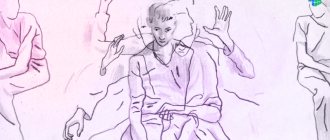This article was developed under the heading: Psychology.
Section: Movements.
The world does not stand still, and with it the views and prejudices of people. The most pressing issue today is the issue of attitude towards people of non-traditional orientation. Social rejection of homosexuality in society leads to a number of problems and disputes, and people’s conservative views give rise to infringement of the rights of gay people, and also make the entire LGBT community quite “disconnected” from others. Let's figure out what homophobia is, who is called a homophobe, and whether we need to fight it.
Homophobia is one of the most serious problems of modern society
What is homophobia and who is a homophobe?
“Homophobia” comes from the Greek “like” and “fear”, that is, homophobia in simple words is the fear of connections with one’s own kind. In fact, the origin of the word does little to explain the very essence of the phenomenon of homophobia as fear. Some sociological institutes and international documents equate homophobia with phenomena such as sexism, xenophobia, and racism.
Homophobia is a negative attitude and reaction to homosexual manifestations, as well as to people belonging to the LGBT community (lesbians, gays, bisexuals, transgender people). Considering that the word “phobia” is a component, homophobia is the obsessive fear associated with manifestations of homosexuality. Thus, homophobes are people who experience fear and (or) hostility towards homosexual, same-sex relationships.
In contrast to homophobia, modern movements are emerging to protect the rights of gay people
Homophobia in psychiatry
Homophobia, like any other phobia, is accompanied by a particularly emotional attitude, hostility, disgust, and aggression towards the object. Despite these signs, homophobia is not a mental disorder. On May 17, 1990, the WHO General Assembly removed homosexuality from the list of mental disorders. And the American Psychiatric Association in 2011 urged not to use this term, given that part of the word “homophobia” is “phobia,” that is, an uncontrollable feeling of fear, which is itself a mental disorder.
Homophobia as a diagnosis
The WHO International Classification of Diseases does not contain such a diagnosis. Homophobia is not considered as an independent diagnosis, since it is not accompanied by manifestations of clinical signs. Currently, the term “homonegativism”, which is more neutral in meaning, has become more frequently used in psychology.
About homophobia
Leonid Prokhorov
Psychologist, Gestalt therapist
Ask a Question
In my practice, people with pronounced aggression and hatred towards LGBT people most often become like this for several of the most common reasons: 1. Stereotypes imposed by parents and the older generation; 2. Opinion and bullying by society. For example, at school they might laugh and mock children who stood out, especially when it comes to the teenager’s orientation. Seeing such a pattern of behavior, a person subconsciously turns on a defense mechanism. This means he switches to the role of an aggressor so as not to play the role of a victim; 3. Psychological trauma; 4. Rejection of one’s own orientation and, as a consequence, the development of an overly aggressive form of homophobia.
I can say that working with such people is extremely difficult. Quite often it takes a long period of time to achieve the slightest result.
History of use of the term
The predecessors of the term “homophobia” are homoerotophobia and homosexophobia. But the first mention of homophobia dates back to 1960. Gay activists Jack Nichols and Lee Clark called heterosexual men's fears and fears of being mistaken for homosexuals homophobia. In 1972, it was used by American psychiatrist John Weinberg in the text of his book “Society and the Healthy Homosexual” to mean the fear of contacts with homosexuals, as well as the negative attitude of people of this orientation towards themselves. Nowadays, the term “homophobia” is used more often for social and political purposes as a kind of tool, due to the large number of different definitions and meanings that are attached to this concept.
The modern concept of “homophobia” has a more complex definition and meaning.
Treatment
Man is a product of society, so he must collectively change his attitude and get rid of homophobia once and for all. The first step, naturally, begins with recognizing the disorder and changing her behavior and attitudes. You need to learn to accept yourself. The main problem is not homosexuality, but the fear of it. Talking about this fear with colleagues or even with children helps to understand the problem and solve it.
If necessary, you can talk to members of sexual minorities and find out about your problems. Actively supporting campaigns or events that address gay issues and eliminate and end prejudice against gay people also has a positive effect on treatment. Misinformation regarding sexual minorities also comes from the Bible, which is actually often misinterpreted. First of all, no biblical text contains the word “homosexuals” in any form. People of the time used the term, but it mostly referred to male prostitutes who were hired by people of either gender.
Many modern scholars have studied these texts and come to the conclusion that the Holy Book never condemned homosexuality. As a society, we must all confront homophobia to create a society that is not only safe for LGBT people, but also respects the differences of all people.
How homophobia developed
The history of the development of homophobia is closely connected with the history of homosexual manifestations. Thus, in ancient Rome, according to the biographies of the ancient Roman historian Suetonius (“The Life of the Twelve Caesars”), only 2 Caesars did not have connections with the male sex. Guy Julius Caesar was called the “Queen of Bithynia” for his bisexuality, but, in particular, for the fact that he had a relationship with the king of Bithynia.
Historians associate the beginning of homophobia with the emergence of religion on the territory of the Roman Empire, namely Judaism, and later Christianity. The basis of such prejudices was that sexual relations should occur solely for the purpose of procreation, and any same-sex intercourse was considered adultery. For example, Emperor Justinian passed a law in 538 that, regardless of sexual position, homosexuals were subject to the death penalty. This law was not the only one, and it was it that influenced the further development of homophobia in Europe. Europe only began abolishing penalties for homosexuality in the 20th century.
Homophobia has been developing for quite a long time. And this, indeed, is largely due to religious movements. In modern times, religion has faded into the background, while one gets the feeling that homophobia is only gaining momentum. The idea that same-sex relationships are impossible is so entrenched in people's minds that it causes strong dissonance and subsequently hatred.
Homophobic states
There are a number of countries where the appearance of homophobic symbols provokes aggression among almost the entire population. It is better for gays, transgender people and lesbians not to visit such states, and if such a need arises, they need to behave and dress in such a way as not to incur “righteous” anger. Countries most dangerous for sexual minorities:
- Yemen;
- Iran;
- Uganda;
- Pakistan;
- Afghanistan.
- Georgia.
- Russia.
These are just a few, in fact we can
Types of homophobia
Homophobia has a broader meaning as a phenomenon. Therefore, homophobia is often used to refer to completely different forms of discrimination that differ from each other in direction, objects, and manifestations. In order to understand and learn to identify homophobic manifestations in human behavior, homophobia was divided into the following types:
Institutional homophobia
Institutional homophobia manifests itself under the influence of anti-homosexual legislation, political statements, religious groups, and public opinion formed under the pressure of such policies. The social life of society is aimed at heterosexuality, accepting traditional orientation as the only correct one. Thus, discrimination and prejudice against homosexuals appears. Politics and culture in this context are very closely related.
For example, American sociologists identify homohysterical cultures. Under their influence, restrictions are established on people's behavior and self-expression through established views, stereotyping, and even through the adoption of norms and rules. In such a society, people tend to constantly prove their heterosexuality. Also, extreme homophobia is inherent in Asian and Middle Eastern cultures, where the thought of homosexuality is not allowed at all. Society through such policies cultivates homophobes, based on the need for procreation, hostility and non-acceptance of homosexual people.
On “legislative” homophobia
Leonid Prokhorov
Psychologist, Gestalt therapist
Ask a Question
I am a person far from jurisprudence and cannot discuss the intricacies of writing laws. But since my practice is still connected with solving the problems and causes of homophobia, it seems interesting to me to consider how we resolve the issue of homosexual relations in Russia. If you open the Constitution or the Family Code, you will see that the law directly states that family and marriage are exclusively the union of a man and a woman. That is, the state directly denies the possibility of same-sex relationships. Moreover, if you are not a person cut off from the media, you have come across terrible stories about how Russians - a couple of men or women could not adopt children, and some even had to immigrate abroad to continue their lives.
Do I consider this state homophobia? Rather yes than no.
Individual homophobia
Individual homophobia manifests itself in the form of open hostility and non-acceptance of homosexuality in connection with the demographic and psychological characteristics of the population. So small towns and rural areas have a more established heterosexual worldview, conservative and religious views. The population of this area is characterized by a predominance of older people.
Individual homophobia is related to the foundations of your family and environment
Internalized homophobia
Internal or internal homophobia is a feeling of hostility, negative reactions of a homophobe towards himself. In simple words, a homophobe experiences negative feelings and emotions about himself from thoughts about same-sex attraction, relationships, even if he is a representative of a traditional orientation. This type is the most dangerous for the individual himself, as it is accompanied by feelings of guilt, complexes, and anxiety, which can subsequently lead to psychological problems, disorders, depression and even suicidal tendencies.
Internal homophobia is quite a common phenomenon among latent, that is, hidden homosexuals. Such a person cannot accept himself and hates his thoughts about same-sex relationships, and therefore everyone who belongs to the category “homosexual”.
Lesbophobia, biphobia and transphobia
Experts identify types of homophobia based on a specific object: lesbians, homosexuals, bisexuals, transsexuals. Some experts associate these types with sexism, misogyny (hostility directed towards the female sex) and other manifestations of gender discrimination. For example, lesbophobia is a manifestation of homophobia based on negative attitudes towards lesbians.
Homophobia among religious and conservative groups
In some ways, this type overlaps with individual homophobia. Religiosity and conservatism are inseparable in most cases. Manifestations of homophobia are most common among believers. Thus, in traditional religions such as Christianity, Islam, Judaism, same-sex relationships are unacceptable and are considered a sin.
In religion, one of the tenets is often a ban on same-sex relationships
Economic costs
There are at least two studies that show that homophobia has a negative financial impact in countries where it is widespread. As a result, there is an exodus of sexual minorities, and there is also a lack of LGBT tourism, the annual share of which, for example, in Spain is $6,800 million.
M. W. Lee Badgett, an economist at the University of Massachusetts Amherst, presented research on the economic impact of homophobia in India at a World Bank meeting in March 2014. In addition to health care costs caused by depression, suicide and HIV treatment, the government spent another $23,100 million due to homophobia. There are also costs associated with violence, job losses, family abandonment, and bullying at school—all of which can lead to lower levels of education, productivity, wages, health, and life expectancy among the LGBT population. In total, she estimated losses in India for 2014 at up to $30,800 million, representing 1.7% of GDP.
LGBT activist Adebisi Alimi has previously estimated that the economic cost of homophobia in Nigeria is about 1% of its GDP. Considering that homosexuality is still illegal in 36 of 54 African countries in 2015, the monetary loss on the continent could amount to hundreds of millions of dollars each year.
Psychological causes of homophobia
Each person may have their own reasons for the manifestation of homophobia; in addition, they can combine with each other, influencing the intensity of homophobic manifestations. Experts include psychological reasons:
- Violations of personal space. Our personal space also includes raising children, so demonstrations of homosexuality can have an impact on their formation. A child in a family can only observe the traditional relationships of parents, but having learned about variability, sooner or later he may be concerned about the issue of self-identification and doubt his orientation.
- Family relationships. Children are brought up on the basis of those examples and models of behavior that they see in front of them in childhood, they accept and understand the worldview and prejudices inherent and accepted in the family.
- Psychological trauma, violence.
- Subconscious manifestation. The point is that people are irritated by the demonstration of homosexuality, which is different from the majority. Irritation manifests itself in the fact that the person himself, due to perhaps early failures, cannot express himself openly and freely (does not necessarily relate to orientation), unlike homosexuals.
Homophobia may be a consequence of parental upbringing
Heterophobia
The term "heterophobia" is sometimes used to describe reverse discrimination or negative attitudes towards heterosexual people and contact with the opposite sex. The term's use in sexology is limited to a few scientists, especially those who question Alfred Kinsey's research into sexual behavior. To date, sexologists have largely not acknowledged the existence or levels of heterophobia. In other fields there is as yet no generally accepted meaning of the term, as it is also used to describe the "fear of the opposite", for example in Pyrrhus André Tagueff's 2001 work The Power of Prejudice: On Racism and Its Spread.
Referring to the debate about the meaning and use of the term, SUN lecturer Raymond Noonan said in a 1999 speech at the Society for the Scientific Study of Sexuality and the American Association of Sex Educators, Counselors and Therapists (AASECT):
“The term heterophobia confuses people for several reasons. On the one hand, some view the disorder as just another social phenomenon that has emerged in pseudoscience and victimology over the past decades.
Many of us recall John Dann's 1995 critique of the influence of victimology and its negative impact on sexology. Others look at the parallels between heterophobia and homophobia and suggest that the former trivializes the latter. For others, it's just curiosity or a game of constructing similar words. But for others, it is still part of both the recognition and politicization of the cultural interests of straight people as opposed to those of gay people, especially where they are perceived as a clash.”
Stephen M. White and Louis R. Franzini introduced the related term "heteronegativism" to refer to the wide range of negative feelings that some gay men may experience and express towards straight people. This term is preferred to heterophobia because it does not imply intense or irrational fear.
Why is homophobia dangerous?
Hostility towards people of non-traditional orientation is dangerous not so much for the homophobe himself, but for society and its development as a whole. Homophobia leads to the following dangerous consequences:
- Deprivation of rights and freedoms of citizens. Thus, representatives of the LGBT community in many countries of the world are deprived of the right to marry, start a family, adopt children, or receive subsidies and benefits from the state. At the same time, homosexuals are deprived of the opportunity to publicly discuss problems - this can be mistaken for propaganda.
- Discriminatory nature. Homosexuals find themselves in an unequal position compared to heterosexual people in terms of rights. Condemnation in society makes them more vulnerable. Homophobia ranks alongside racism and leads to restrictions on a certain group of people.
- Increase in crime. Radical, aggressive manifestations of homophobia lead to crimes and violence against members of the LGBT community. Cruelty towards homosexuals often causes them to commit suicide.
In fact, the listed restrictions regarding the LGBT community give rise to society's struggle against homophobia. At the moment, many parallel currents are trying to defend the interests and rights of other minorities.
About same-sex marriage
Many people ask the question, why is it necessary to register such unions? To begin with, the right to marriage is enshrined in the Human Rights Convention. It states that men and women have the right to marry without violating national laws. Only 42 countries have partially or fully legalized same-sex marriage; in the rest it is not legal. That is, same-sex partners in these states are not considered family members and do not have the legal rights that are provided in traditional unions.
The legal aspect is of no small importance. For example, partners in such couples do not have rights to inheritance unless a separate agreement or will is concluded, they cannot inquire about their health status if one of them is in a medical institution, and they cannot adopt children. In almost all cases, heterosexual couples have preferences over homosexual ones.
Main causes of homophobia
Most people consider homophobia to be a normal phenomenon, justifying it by saying that it is simply unpleasant for them to be in the company of people of non-traditional orientation. It is possible that such an option may well exist, but the whole point is not only in the attitude of a person, but also in his behavior and manifestations. Let's look at some of the reasons for homophobia.
Too open LGBT relationships
Most homosexuals try to hide their different sexual views and preferences from others. Over time, they began to talk about homosexuality more often; holding gay pride parades and LGBT communities opens up to society the problem of discrimination against non-traditional relationships. But these same open manifestations lead to some misconceptions among people:
- Promotion of non-traditional sexual relations among minors. Some people believe that such open manifestations in the form of gay pride parades can influence children's determination of their orientation.
- Western influence on people. The growth of intolerance and the association of homosexuality with the political and ideological influence of the West.
“Propaganda” of homophobia
Leonid Prokhorov
Psychologist, Gestalt therapist
Ask a Question
The phrase “they promote homosexual relations” sounds quite strange to me. And when heterosexuals, that is, a man and a woman, demonstrate that they are in a relationship – is this also propaganda? In my opinion, this is a rather subjective and unfounded position. For example, if you are interested in video games or you have children who are involved in this culture, then you have probably heard about the game “The last of us”. So this game caused such a storm of indignation from the homophobic community that the ratings of the game, beautiful in its plot, became the lowest in history. There was only one complaint - a demonstration of the main images of the LGBT community: lesbians, chauvinists, homophobes, transgender people and the image of a courageous woman. As a result, the game received the label “a game for the LGBT community.”
Personally, I didn't feel like the character reveal was in any way propaganda-inducing or left too much time for the characters' gayness to be revealed. However, for aggressive homophobes, just the mention of non-traditional relationships is enough.
Social influence
The attitude of the environment and society has a great influence on the formation of both the person as a whole and the formation of individual views and prejudices regarding many issues. Homophobia was no exception: since the 60s, when sexual minorities began to openly defend their rights, hostility towards homosexual manifestations also began to be more openly expressed in people's behavior. A negative attitude towards those who, by some criteria, differs from the majority of people has always existed.
The social ideological system denies non-heterosexual forms of behavior. Thus, established views on traditionalism and their imposition on the younger generation leads to the development of homophobia by society itself.
The environment has the strongest influence on the formation of homophobic behavior
AIDS
In the 1980s, medicine was faced with the spread of AIDS (human immunodeficiency virus), a serious viral disease. The first patients with this disease practiced homosexual relations, so homohysteria reached a high level during the AIDS epidemic. Later, doctors found that the virus is transmitted sexually, as well as through the use of unsterile needles and other unsterile medical instruments, transfusion of infected blood and similar methods. However, the rise of homophobia and the belief that gays are “infecting society” has not stopped.
Fear of finding homosexuality in yourself
Another reason for the development of homophobia is the fear of discovering homosexual tendencies in oneself. Susceptibility to social influence reaches such levels that people, being of traditional views, are afraid of the possible discovery of other sexual views in themselves. This happens most often when in childhood a child was strongly attached to a member of the same sex, but over time he suppressed this tendency under external influence. People are afraid of not being like the majority; an aggressive attitude towards homosexuality can be expressed even to physical violence and murder.
Fear of one's own homosexuality in severe cases can lead to depression and even cases of self-harm
Indicative homophobia to hide your LGBT relationships
Homophobia occurs even within the LGBT community. In cases of demonstrative homophobia, a person is confident that his orientation is unconventional, perhaps he already has a relationship with his gender, but by showing homophobia towards people with the same orientation, they try to disguise their preferences. So, they are trying to protect themselves from the attacks of society.
Current state of affairs
Homosexuality is illegal in 74 countries. The North Korean government condemns Western gay culture as a vice caused by the decadence of capitalist society and decries it as encouraging consumerism, classism and promiscuity. In North Korea, "violating the rules of collective socialist life" can be punished by up to two years in prison. However, the position of the North Korean government is as follows: “As a country that has acquired science and rationalism, the DPRK recognizes that many people are born with an unconventional orientation, that this is a genetic trait and treats it with due respect. Sexual minorities in the DPRK have never been repressed, as in many capitalist regimes around the world.”
Robert Mugabe, the former president of Zimbabwe, waged a brutal campaign against the LGBT community, arguing that same-sex relationships were not practiced in their country before colonization. His first major public condemnation of homosexuality was in August 1995 during the Zimbabwe International Book Fair. He told the audience: “If you see people acting like lesbians and gays, arrest them and hand them over to the police!” In September 1995, Zimbabwe's parliament introduced legislation prohibiting homosexual acts.
Problems of homophobia
The problems of homophobia lie not so much in the existence of homosexuality, but in the attitude of other people towards representatives of sexual minorities. Generally accepted forms of behavior, stereotyping and beliefs of society try to mold each person into similar ones, and the appearance of distinctive features causes suspicion, mistrust, and hostility within groups.
Homophobic violence
One of the most important problems of homophobia is homophobic violence. Homophobic violence – acts of physical and mental pressure based on sexual orientation, expressed in acts of a violent nature. Homophobic violence in the form of bullying occurs even in schools among children, threats from outside, blackmail, bullying. The victims of such violence may not be representatives of the LGBT community, but arouse such suspicions, for example, an overly mannered guy, a masculine girl. The stereotyping of human views leads to labeling of people, cruel treatment, hostility, hatred, even aggressive actions towards them.
Unfortunately, bullying, bullying, and violence against LGBT people quite often become the cause of tragic situations. Thus, it is not uncommon in America for schoolchildren who were subjected to violence by classmates for being gay to take it out on their offenders.
Can homophobia become a reason to understand oneself?
Earlier I said that homophobia is expressed not only in the non-acceptance of homosexual manifestations in other people, but also in the negative attitude towards homosexuality in the person himself. The fear of having different sexual views, “deviating from the norm” can serve as a reason to understand oneself. Doubts about one's personal orientation can reduce the quality of life in society. That is why it is important to understand what causes homophobic manifestations - hostility towards others or fear of being among them.
If you realize that you cannot accept your own orientation, and this is causing you an unstable state, be sure to contact a specialist who will help you accept yourself.
Homophobia as a special case of xenophobia and discrimination in Russia
Homophobia is a special case of broader xenophobia. Xenophobia is fear of the unknown, the incomprehensible. Any type of xenophobia is accompanied by a discriminatory nature. The relationship of one race to another, men to women, one religion to another. In the case of hostility caused by a different orientation, this is a fear of unconventional manifestations.
In any case, xenophobia occurs due to misunderstanding, an irrational fear of what is a “deviation”, a difference from the generally accepted. In Russia, the prohibition of discrimination on national, racial, and religious grounds is legally enshrined. But there is no prohibition of discrimination based on gender or sexual preference; on the contrary, such discrimination is emphasized. Recently, attitudes towards sexual minorities have changed for the better, but this is not being consolidated at the state level. Western countries often use the phrase “breeding ground of homophobia” specifically in relation to Russia.
In general, Russia is a very homophobic country
Classification
The pamphlet, produced by Save Our Children (a political coalition formed in 1977 in Miami, Florida, USA), sought to repeal a recently passed statute prohibiting discrimination in housing, employment, and public accommodations on the basis of sexual orientation.
The disorder manifests itself in different forms, including internalized, social, emotional, rationalized homophobia and others. There were also ideas to classify gay hatred, racism and sexism as intolerant personality disorders.
In 1992, the American Psychiatric Association, recognizing the power of disgust toward homosexuality, published the following statement, reaffirmed by the Board of Regents in July 2011: “Unless gay orientation itself implies impairment in judgment, stability, reliability, or general social or vocational abilities, the American Psychiatric Association The Association (APA) calls on all international health organizations, mental health organizations and individual physicians in other countries to urge the repeal of legislation in their countries that penalizes homosexual acts by allowing adults to live freely in their private lives. We ask these organizations and individuals to do everything they can to reduce the hatred associated with homosexuality, wherever and whenever it occurs."
Is homophobia passed on from parents?
We all know that external signs and character traits are inherited by children from their parents. In addition, heredity determines many diseases not only of parents, but also of other relatives, for example, myopia, diabetes and others. Disputes about the hereditary transmission of homophobia are still raging. Let's try to figure out whether it is possible to transmit homophobic manifestations from parents.
Genetic transmission
According to scientists, genetic transmission of sexual inclinations is possible; for example, according to some studies, the manifestation of homosexuality is 25% dependent on the inherited gene. But the preservation of such a gene tends to zero due to the specifics of homosexual relationships. As for the gene responsible for homophobic manifestations, no results of official studies confirm, but do not exclude its existence.
Transmission in education
The development of homophobic manifestations, as well as sexism, racism and xenophobia in general, begins in childhood, largely under the influence of the family. The stereotypical views of parents, their prejudices, and religious views are formed over generations and are passed on in the same way. Children are given an understanding of what is good and what is bad depending on the understanding of their parents. The child experiences the world and learns to socialize by adopting the patterns of behavior that he observes in his family. Experts include some forms of transmission of homophobia within a family:
- Absence, silence or insufficiency of sex education for children and adolescents;
- Statements, reproaches of appearance;
- Imposition of homophobic prejudices - heterosexuality is presented as the only correct option;
- Prohibitions on relationships with the opposite sex. Often accompanied by the phrases “it’s too early for you to think about this”, “when you grow up, you’ll find out”;
- Stable stereotypes and their imposition regarding correct behavior, tastes, etc.
The transmission of homophobia to children is possible only through education and instillation of a certain kind of thoughts
Fighting homophobia
Having dealt with the influence of homophobia on society, it is worth touching on the widespread problem of combating its manifestations. On May 17, 1990, homosexuality was removed from the WHO list of diseases, and this day is now recognized as the International Day against Homophobia. The goals of the fight against homophobia are:
- Support for gay citizens;
- Equalization of rights, regardless of sexual preferences and membership in the LGBT community;
- Prevention of physical and moral violence towards people of a different gender or orientation.
Events to combat homophobia can be called queer pride (a broader concept than LGBT, it includes asexuality, transgenderism, gender identity and others) or LGBT pride. Pride is a kind of mass coming out (open and voluntary recognition). Pride parades are organized so that people have the opportunity to openly express their beliefs, sexual preferences, and attitudes towards other orientations. Thus, people have the opportunity to learn about the existence of such problems as discrimination based on gender and non-traditional orientation, and representatives of the LGBT community themselves find support and are convinced that they are not alone.
In 2021, there are many social movements that fight homophobia
Tolerance should not be confused with love
Now the younger generation is more tolerant of manifestations of homosexuality, young people are much freer and older generations value personal freedom more, and strive for universal equality of people in our modern society. A tolerant attitude does not mean love at all. Even when experiencing hostility and homophobic manifestations, a person can remain tolerant of the object of intolerance.
LGBT communities in their struggle strive to achieve a certain kind of “neutrality” in relation to people. They do not require a more attentive attitude to their lives, but only recognition of all the rights of other people and a respectful attitude that excludes aggression and hatred
Who is right in this current debate?
The debate about the positive impact of the development of tolerance in society has two sides: some believe that tolerance is a pretense, tolerance that can suppress the expression of one’s own opinion, others, on the contrary, believe that the education of tolerance is the only way to equalize inequalities of various kinds, the main tool for achieving balance in society. There are so many people and so many opinions, it is impossible to definitely and accurately say who is right. We can say that the use of tolerance for political purposes negatively affects people’s attitude towards its necessity.
About annoying tolerance
Leonid Prokhorov
Psychologist, Gestalt therapist
Ask a Question
Probably most of you have come across the fact that the word “tolerance” is used everywhere, even inappropriately. Such “propaganda” of tolerance entails the most negative consequences - anger, hatred and irritation of people. I cannot say that current policies and media activities have a positive effect on the fight against homophobia. Tolerance in people should be cultivated and presented as a value, and not act as a duty.
How to overcome homophobia in yourself
When a person feels fear or hostility towards something, including homosexuality, the degree of aggressiveness of these manifestations is important. Understanding and awareness of the destructiveness of homophobic manifestations is the main point in the fight against internal homophobia. Analyze the impact your expressions have on members of sexual minorities. If you are concerned about your attitude, overly emotional reactions, aggression, or a desire to belittle members of the LGBT community, consult a psychologist. A specialist will help you understand the reasons for the emergence of homophobia; perhaps they are imposed by society. The desire to overcome homophobia in oneself, the awareness that people are all different and same-sex relationships can exist are the main means to combat these manifestations.
You can, for example, get carried away by the philosophy of pacifism. This will be an excellent alternative to such radical movements as homophobia.
Going to a psychologist is one of the most effective options for combating your own homophobia
Lesbophobia
Some experts and activists have proposed a special term : lesbophobia
(eng.
lesbophobia
) for a specialized designation of negative reactions specifically against lesbians. According to representatives of the French Center for Combating Homophobia, such isolation is important due to the fact that lesbians, compared to gays, are reluctant to admit to facts of discrimination against them, although in reality such facts do occur[52]. Lesbophobia is associated with some specific stereotypes, such as prejudice against female athletes due to suspicions that most of them are lesbians.[53] So far, however, the division of the concept of homophobia into prejudice against gays and prejudice against lesbians remains rarely used.
Should we fight homophobia?
All over the world, more and more decisions are being made to combat homophobia. A person’s orientation does not affect his personal qualities; representatives of the LGBT community remain the same people as people of traditional orientation. So, why should their rights be violated? A large number of young people are aware of their difference from the accepted “norm”; pressure and misunderstanding lead to devastating consequences, including committing suicide. Aggressive homophobia manifests itself in violence, cruelty and murder in seemingly quite peaceful times.
AIDS
Another common misconception is that AIDS is a gay disease. At first, it even had a different name - “immunodeficiency associated with homosexuality.” This is largely influenced by the lack of information and condemnation by the surrounding society. The fact is that after conducting more thorough research, scientists determined that infectivity with this virus is not related to orientation.
For example: in Russia, more than half of the cases of infection occurred through traditional heterosexual relationships, although members of the LGBT community are at risk and get sick more often.
Read also: How to make a wolf out of paper step by step
Homophobia in the world
All over the world, homophobia is one of the most discussed problems. The flag of homophobes is a rainbow flag (like the flag of the LGBT community), but this rainbow is crossed out by a black line in a circle. The attitude of different countries towards manifestations of homosexuality depends on the culture, religion, and traditions common in the country.
One of the flags of the homophobic community
Homophobic states
There are more than 80 countries in the world where people are most negative about homosexuality. To the point that same-sex relationships are persecuted and criminalized, but even worse is that in some countries the highest penalty is death for same-sex relationships. These are mainly countries of the Muslim world. They are considered the most dangerous for representatives of sexual minorities. Examples of homophobic states:
- Iran. Although the Iranian authorities officially do not apply any types of punishments to people of unconventional orientation, entire groups of militants are dealing with this. There may even be suspicions of homosexuality due to a man’s excessive femininity and grooming.
- Uganda. In Uganda there is a law called “kill the gay”. A person can be punished even for watching films on a prohibited topic. The media often publish messages calling for reprisals against gay people, and information and personal data of homosexuals themselves are also published.
- Saudi Arabia. The cruel laws of this country are known to many. Homosexuals there are subjected not only to prison terms and fines, but also to chemical castration, flogging, and beheading. Rigid conservative views and “living by Sharia law” make this country one of the most homophobic countries in the world.
In Russia, homophobia is determined by specific regions. Thus, in Moscow they are tolerant of LGBT people. On the territory of the Caucasian republics - Chechnya, Dagestan, etc. homosexuality is denied in principle.
Homophobia in the USA
Same-sex marriage was legalized in the United States not long ago. The anti-homophobic movement is developing and being supported. However, on a territorial basis, there are states where homophobia is most pronounced: Texas, New York, Louisiana.
Homophobia in Russia
Russia is not the best country for gays to live. More often, authorities try to avoid such problems as homophobia. But they are trying in every possible way to limit the rights of sexual minorities at the legislative level, for example, banning the promotion of non-traditional relationships, same-sex marriage, holding rallies and parades. However, no matter how Western Russophobes call Russia a “breeding ground for homophobia,” some manifestations of the fight against it can be observed. In 2018, a social network user in the Sverdlovsk region was fined for a homophobic comment.
Homophobia in Europe
Recently, Europe has not been distinguished by its loyalty to LGBT people, although it is worth considering that the level of tolerance is much higher than the world average. According to the survey, 26% of respondents were attacked or threatened for having unconventional sexual views, 20% of gays and bisexuals were discriminated against at work.
Frequent anti-LGBT rallies throughout the European Union only prove that the level of homophobia is not so different from countries with strong traditional foundations.
Homophobia in Asia
Asia has not legalized same-sex marriage, although some countries are taking steps to combat homophobia. For example, Nepal prohibits persecution based on orientation, and the country also allows citizens to choose a third gender. Japan does not legally define what gender a husband and wife should be.
Homophobia as a phenomenon is widespread throughout the world
Story
In medieval Europe, homosexuality was considered sodomy and was punishable by death. The situation reached its climax during the medieval Inquisitions, when the Cathar and Waldensian sects were accused of adultery along with Satanism. In 1307, accusations of sodomy and same-sex relations were the main motives for the trials. The theologian Thomas Aquinas was influential in linking condemnations of homosexuality to the idea of natural law, arguing that "certain sins are contrary to nature, such as those which occur between members of the same sex, and are classified as unnatural vices."
Although bisexuality was accepted as typical human behavior in ancient China, homophobia began to take root in the late Qing Dynasty and the Republic of China due to interaction with the Christian West, and same-sex relationships were outlawed in 1740. When Mao Zedong came to power, the government declared homosexuality to be "a social disgrace or a form of mental illness." During the Cultural Revolution (1966–1976), minorities faced the worst persecution in Chinese history. Despite the absence of a similar law in the communist People's Republic, "police officers routinely arrested gays and lesbians." Other rules were used to prosecute homosexuals, "accusing them of disorderly conduct or disturbing the peace."
In Russia in 1922, under the leadership of Vladimir Lenin, long before it happened in many other European countries, the CPSU effectively abolished all the old Tsarist laws and the original Soviet criminal code and began to use liberal sexual policies. This was abolished a decade later by Joseph Stalin, and same-sex relationships remained illegal under Article 121 until the Yeltsin era. Homosexuals were one of many groups, along with Jews, who were killed during the Holocaust.











